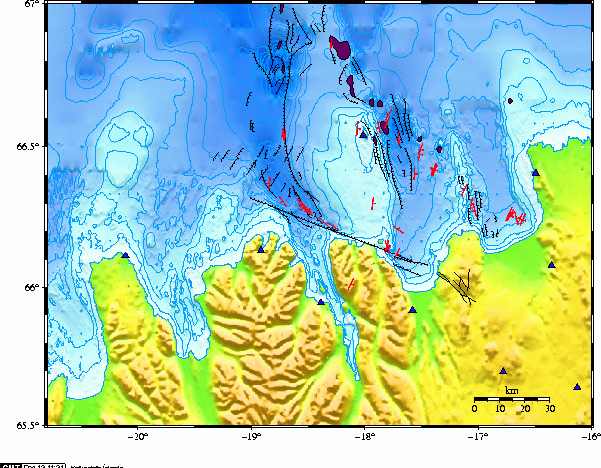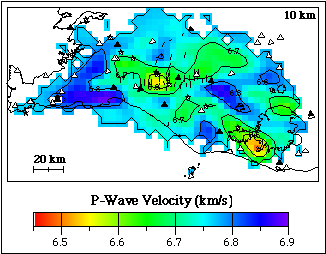
Subproject 3
Reynir Boedvarsson Department of Geophysics Uppsala University Villavaegen 16 SE 752 36 Uppsala Sweden Phone +46 18 182378 Fax +46 18 501110 rb@geofys.uu.se
The SIL micro-earthquake system produces detailed results of automatic analysis of large number of micro-earthquakes. To be able to work efficiently with this kind of information a special interactive program had previously been created. During the PRENLAB project, this program has now been further developed and allows now the results from single event location, from multi-event location, from fault plane solution, and from rock stress tensor inversion as input. The program can now be used for steering results from one analysis to another, for example can the relative locations give constraint on the fault plane orientation which can be used in the input for both fault plane solutions and rock stress tensor inversion. The development of this interactive software has also required modifications in all other software to facilitate the information flow between the different algorithms.
TASK 1: Methods for sub-CRUSTAL mapping of faults.
The algorithm for absolute and relative location of micro-earthquakes has been
implemented in the SIL system routine analysis.
This software has been applied in a search of crustal faults both in
the north (Tjornas Fracture Zone) and in the SIL area. This work has been
in cooperation with geologists and these faults found from the micro-earthquakes
show a remarkable agreement with the fault information available from
sea bottom and land surveys. These studies also indicate the power of the
multi-event location technique for discriminating the fault plane and the
auxiliary plane. A paper will soon be submitted for publication.
An example of the results using this algorithm is shown in the figure below.

Some preliminary work has been carried out towards inversion for the
3-d velocity structure in the SIL area.
velocity structure in the SIL area. The first results show an interesting
velocity anomaly at the lower boundary of the brittle crust. See figure.

TASK 2: Methods for monitoring the crustal wave velocities.
Nothing has been done on this yet. It will be more efficient to work on this when the SIL database is completed.
TASK 3: Methods for monitoring the local rock stress tensor.
Software for rock stress tensor inversion based solely on micro-earthquake information is under development. Stress tensor inversion based on only micro-earthquake information has a crucial point in the choice of fault plane (eliminating the auxiliary plane). This new software allows to base this choice on not only the fit to the stress tensor for the slip direction but also due to stability and (perhaps most promising) due to relative locations of closely spaced similar micro-earthquakes. This allows a stress tensor inversion completely based on direct information from the micro-earthquakes without adding restrictions based on surface geology. The state of the work is that the software is developed and implemented in the SIL system context. At present tests with synthetic data and with real data from the SIL area are performed.
TASK 4: Methods for monitoring stable/unstable fault movements.
This part of the project depends highly on the results from Task 1 and Task 3. This will thus be the last task to be finalized within the project. However, a thorough testing of the various algorithms used in the micro-earthquake analysis is being worked on. The first step was to test the automatic algorithm for the fault plane solution. This has been done by performing full waveform inversion for the moment tensors for a few selected earthquakes in the SIL area. The results show a very good agreement with the automatic fault plane solutions produced by the SIL system. This paper will be submitted for publication during 1996 or early 1997.
TASK 5: Methods for statistical analysis of the space/time distribution of micro-earthquakes and earthquakes.
This task will be worked on when the SIL database is available.
TASK 6: Development of a method for acquisition of continuous GPS data through the SIL system.
The software for transferring GPS data to the center in Reykjavik has been completed. We have had difficulties in getting information about software and/or software protocols for the Trimble 4000 GPS instruments. We have been trying to use DOS software from Trimble running under a DOS emulator for Interactive Unix, which is the operating system used at the stations. This has not succeeded as yet. So there is no continuous GPS data recording as by now. Our plan is to try some other solution to the problem and hopefully we will get things going in late January 1996.
B÷varsson, R., R÷gnvaldsson, S. Th., Jakobsdˇttir, S., and Slunga, R., Stefßnsson, R. 1996. The SIL data acquisition and monitoring system. Seismological Research Letters. pp 35-46.
B÷varsson, R., R÷gnvaldsson, S. Th. and Slunga, R., 1996: Waveform correlation as a tool for automatic phase picking. Abstracts of the XXV General Assembly of ESC, ReykjavÝk. p. 32.
Gumundsson, G. Steinunn Jakobsdˇttir, Reynir B÷varsson, 1996. Automatic selection of teleseismic data in the SIL system. Abstracts for the 25th ESC General Assembly. B2.09, p. 34.
R÷gnvaldsson, S. Th., Gumundsson, ┴. and Slunga, R., 1996: Seismicity and style of faulting in the Tj÷rnes fracture zone, North Iceland. Abstracts of the XXV General Assembly of ESC, ReykjavÝk. p. 74.
Stefßnsson, R., Bodvarsson, R. and Gumundsson, G. 1996. Iceland plume tectonics. Some speculations and facts. In: Thorkelsson, B. (editor) Seismology in Europe. Papers presented at the XXV ESC General Assembly. ISBN 9979-60-235-X. ReykjavÝk, pp. 505-511.
Tryggvason, A. and Rognvaldsson, S. Th., 1996: 3-D P- and S-wave velocity structure beneath south-west Iceland derived from local earthquake tomography. Abstracts of the XXV General Assembly of ESC, ReykjavÝk. p. 59.
Slunga, R. and Lund, B., 1996: Stress Tensor Inversion based on micro-earthquake focal mechanisms. Abstracts of the XXV General Assembly of ESC, ReykjavÝk. p. 33.
Shomali, Z. H. and Slunga, R., 1996: Determination of the mechanism and source parameters of earthquakes by using moment tensor inversion of earthquakes in the South Iceland Seismic Zone. Abstracts of the XXV General Assembly of ESC, ReykjavÝk. p. 75. Some more references should be here !!
The tasks, 1, 2, 3 and 6 will be finalized during the current PRENLAB project period. Tasks 4 and 5 should continue into the next project period. These are the ultimate goals of this subproject. In addition, a new task involving a thorough modularization of the software developed within the PRENLAB project. This is necessary to be able to meet the large interest in the SIL software shown by seismology institutions, both in and outside the EU. I think it is sexy for the EC to get results from such a project directly used by other EC members and exported to the outside.